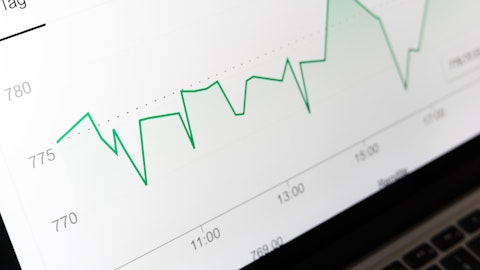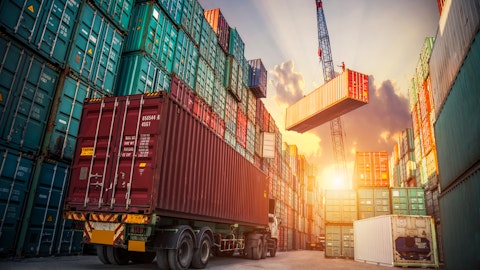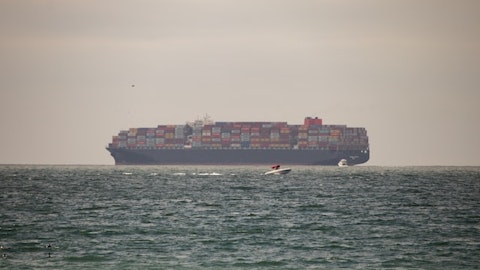So, the big variations of freight rates in 2023 is not attributable to demand, the demand was particularly strong, and one of the strongest demands we’ve seen in the last five years. It was attributable to the effective supply of ships. While we did not have a big increase of the fleet on a nominal basis by deliveries of new buildings in 2023, we had big variations in respect of congestion and various other trade, problems in various areas. The reason why we saw the sharp decrease in the second quarter of the year, and, of course, in Q1, was the fact that the grain corridor in the Black Sea was unwound, and a lot of Panamax and Supramax vessels were automatically released, about 200 ships were released looking for employment. From September onwards, we saw congestion creeping up to the historical averages.
Then we had the Panama Canal situation where kind of locked a number of smaller ships at that area. And then the Red Sea, the Red Sea situation is something that is still, we still wait to see the effect of that problems, and the fact that the vessels are deviating around the Cape of Good Hope. So, overall, I strongly believe that demand will continue to be very healthy in 2024, even if it remains at the same numbers like 2023. It’s a very strong and very healthy demand, and the actual variation of the freight rates will be a derivative of the effective supply of vessels. So, the less ships available and the bigger the deviations to avoid, conflict areas, the higher the rates. And I strongly believe that the effect of the Red Sea is, the full effect of the Red Sea deviation is yet to be seen.
We will see that towards mid to end of Q2, in our opinion. I hope that covers your question.
Liam Burke: Yes, it sure does. Thank you. The other question I had is on the special dividend. Is that going to be incorporated in your normal capital allocation program?
Stamatis Tsantanis: Well, for us, it’s very important to reward our shareholders, and we have demonstrated historically that we’ve paid hefty dividends to our shareholders to the extent that, cash flow and cash balances allows. When we had experienced a very volatile year like 2023, where rates ranged from $2,500 a day to $55,000 a day, you can imagine that we must be cautious with the distribution of our cash. However, as we’ve stated in our release, we have already fixed the number of our vessels for Q1 and of course for Q2. So, we have crystallized a big amount of our cash flow. And if the situation allows, we might incorporate the special dividend into the regular dividend or further increase the special dividend. We have not decided yet. We will wait and see. But the overall strategy is to reward the shareholders as much as we can.
Liam Burke: Great. Thank you very much.
Stamatis Tsantanis: Thank you. Nice to hear from you.
Stamatis Tsantanis: [Operator Instructions] We are now going to proceed with our next question. And the questions come from the line of Kristoffer Barth Skeie from Arctic Securities. Please ask your question. Your line is open.
Kristoffer Barth Skeie: Hello, guys. Thank you for taking my question. How are you?
Stamatis Tsantanis: Hello and very good afternoon. Nice to hear from you. And sorry to hold the conference call on a Friday so late for European time.
Kristoffer Barth Skeie: No, no. That’s perfectly fine. And obviously, congrats on a very good quarter. Strong finish to the year. And I must say that the Capesize transaction seems to be extremely well done. I mean, we have a generic Capesize built in 2013 valued at $40 million now. So, already deep in the net money. So, congrats on that. I was just wondering if you could comment on what has been the recent strength in the market during Q1. And sort of if the strength in Q1 is driven by a very strong volume growth, what should we expect from the remainder of the area sort of the upside of volumes is already taken out? What’s your view on that?
Stamatis Tsantanis: Well, thank you. As I mentioned to Liam before, I believe that the current strengthening of the Capesize rates is a combination, first of all, of the restocking of China. I remind you that in December, the Chinese iron ore stockpiles were down at 105 million tons. Now, it’s the beginning of the construction season in China. So, they need to restock iron ore. They produced a very strong amount of steel last year and we expect them to be consistent this year as well. For a number of reasons. I believe that the, and we have discussed this extensively internally, that the variation of the rates for 2024 will be a product of how the effective vessel supply is going to be moving around the world. We still see the Red Sea disruptions affecting, in our case, they have affected about 20% of our fleet, which is very strong.



